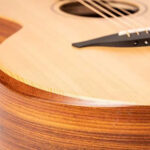Ludwig Van Beethoven’s “Piano Sonata No. 14 in C# minor Quasi una Fantasia,” universally known as the “Moonlight Sonata,” stands as one of the most evocative and unforgettable compositions in music history. While originally conceived for the piano, this masterpiece translates beautifully to the classical guitar, offering a new dimension to its haunting melody. This article explores the allure of playing Moonlight Sonata on the guitar, focusing on the accessible 1st movement ‘Adagio Sostenuto’ and how guitar tablature can unlock this piece for guitarists of varying levels.
The original composition is in C# minor, but for guitar, it’s commonly transposed to A minor to facilitate easier finger positioning on the fretboard. For those seeking to play closer to Beethoven’s original key, employing a capo becomes a simple yet effective solution, allowing you to maintain the guitar-friendly fingerings while shifting the pitch.
As you embark on learning Moonlight Sonata on guitar, particularly with the aid of guitar tablature, keep these key considerations in mind to enhance your performance and understanding:
- Capo for Original Key: Placing a capo at the 4th fret will transpose the guitar to the original key of C# minor, bringing you closer to the intended sound of Beethoven’s composition. This is particularly relevant if you aim for a performance that mirrors the original piano voicing.
- Chordal Harmony: Approach the piece with a chordal mindset rather than solely focusing on individual notes. Recognizing the underlying harmonic progressions will not only simplify the learning process but also enrich your musical interpretation. Understanding the chords provides a framework for the melody and bass lines, making the guitar tablature more intuitive.
- Dynamic Nuances: Maintain a dynamic range primarily between piano (soft) and mezzo forte (moderately strong). This dynamic restraint is crucial to capturing the delicate and introspective character of the Adagio Sostenuto movement. Listen to piano performances to internalize these subtle dynamic shifts and translate them to your guitar playing, using the tablature as your guide to note accuracy.
While Moonlight Sonata isn’t technically overwhelming on the guitar, mastering its expressive qualities requires careful attention to phrasing. Certain passages feature long, sweeping phrases that can feel syncopated due to their extended length. It’s easy to lose your sense of musical direction in these sections. Therefore, listening attentively to interpretations by renowned pianists is highly recommended. Guitarists sometimes diverge in their interpretations, but adhering closely to the pianist’s phrasing, especially in a piece originally conceived for piano, can bring you closer to the composer’s intent. Guitar tablature accurately reflects the notes, but listening to piano versions informs your musicality and phrasing beyond the notes on the page.
Beethoven’s Enduring Musical Style
Ludwig van Beethoven’s musical style serves as a pivotal bridge between the Classical and Romantic eras. His compositions are defined by dramatic contrasts, groundbreaking structures, and profound emotional expression. Beethoven was a master of bold harmonic progressions, sudden dynamic changes, and intricate thematic development. He expanded upon the traditional forms of his time, infusing them with a deeply personal and emotional voice. His unique ability to convey a vast spectrum of human emotions, from tranquility and introspection to passion and heroism, is what makes his music perpetually relevant and profoundly influential. When learning Moonlight Sonata Guitar Tablature, understanding this stylistic context can deepen your appreciation and performance.
Exploring Beethoven’s Masterpieces
To further appreciate Beethoven’s genius, consider exploring these five notable compositions:
- Symphony No. 5 in C minor, Op. 67: Perhaps his most iconic work, known for its dramatic opening motif.
- Symphony No. 9 in D minor, Op. 125 (“Choral”): A monumental symphony featuring the famous “Ode to Joy” in the final movement.
- Piano Concerto No. 5 in E-flat major, Op. 73 (“Emperor”): A majestic and virtuosic piano concerto.
- Piano Sonata No. 8 in C minor, Op. 13 “Pathétique”: Another deeply emotional and dramatic piano sonata, showcasing Beethoven’s expressive range.
- Violin Concerto in D major, Op. 61: A lyrical and technically demanding concerto for violin.
Let your fingers dance across the fretboard and bring the Moonlight Sonata to life on your guitar! Guitar tablature is your key to unlocking this timeless masterpiece and experiencing its beauty in a new light.
Josh
(Note: Course Information, Course Instructor, and Learn to play Moonlight Sonata sections from the original article would follow here if the intention was to fully replicate the original page structure. However, based on the instructions, this rewritten article focuses on providing enhanced content around “moonlight sonata guitar tablature” and would likely link to course information or tablature resources on guitarplayers.net instead of directly embedding the course details within this article itself for SEO purposes.)

